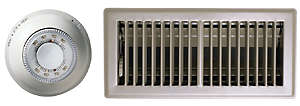
 |
|
 Central air conditioners are "split systems," which means that there is an outdoor unit (condenser) and an indoor unit (coil). The function of an air conditioner is to transport heat from one "station" to the other. The "vehicle" your system uses to carry the heat is called refrigerant. In AC operation, the compressor in your outdoor unit pushes the liquid refrigerant through copper tubing into the evaporator coil located in your fan coil unit or attached to your furnace. As the refrigerant is compressed, it turns into a gas. When it moves through the evaporator coil, the refrigerant takes on heat from the air circulating over the coil. The cooler air is then recirculated into your home. Meanwhile, the heat absorbed by the refrigerant is carried outside through the copper tubing and given off to the outside air as a fan pulls the air over the condensing coil in your outdoor unit. While it's keeping you cool, your air conditioner also works as an effective dehumidifier. As warm air passes over the indoor evaporator coil, it can no longer hold as much moisture as it carried at its higher temperatures. The extra moisture condenses on the outside of the coils and is carried away through a drain. The process is similar to what happens when moisture condenses on the outside of a glass of ice water on a hot, humid day. Some frequently asked questions: Why do I need to match my condensing unit and outdoor coil in a new system? Imagine four old, worn-out tires on your car. You decide to replace only two of them. You can still drive your car, but you'll soon be disappointed with the inconsistent handling and the poor mileage you get. The unmatched tires simply aren't capable of the same level of performance. You could have these same kinds of problems with comfort and efficiency if the components of your central air conditioning or heat pump system are not properly matched. So if you install a new outdoor unit, be sure to include a new, equally efficient "matched" indoor unit. What is a SEER rating? Cooling efficiency for air conditioners and heat pumps is indicated by a SEER (Seasonal Energy Efficiency Ratio) rating, which tells you how efficiently a unit uses electricity. The higher the number, the greater the efficiency. The typical SEER rating of units manufactured prior to 1992 is about 6.0. In 1992, the government established the minimum cooling efficiency standard for units installed in new homes at 10.0 SEER. High-efficiency units have a SEER of at least 12.0; the maximum available is about 17. What's with all the noise in my yard? Sometimes noise from condensing (outdoor) units interferes with your peace outdoors and even your quiet indoors. It's a factor you should at least look at when you're comparing different models. The sound level of outdoor units is measured in bels (similar to decibels), on a scale from 0 (barely perceptible sound) to 13 (the threshold of pain). Most air conditioners and heat pumps operate at 8 to 9 bels; some units' ratings are as low as 6.8. That may not sound like a wide range, but consider this: 9 bels sounds 10 times louder than 8 bels. That means one 9-bel air conditioner is as loud as 10 units rated at 8 bels. Taking the time to compare bel ratings is pretty sound advice. What are some other comfort considerations? Some air conditioners and heat pumps offer additional features that provide greater comfort. Two-speed units can run on low speed (using 50% of the energy) up to 80% of the time, so they offer the same benefits as multi-capacity furnaces - fewer on/off cycles, fewer drafts and much smaller temperature swings. You also get better air circulation, for even, consistent cooling and/or heating throughout your home. Plus, if you purchase a multi-speed or variable-capacity furnace or fan coil with your unit, you will enhance both the comfort and the efficiency of your air conditioning or heat pump system even further. |
|
Call us at 212-555-4321 for emergency service or a free estimate on upgrading your existing system. |